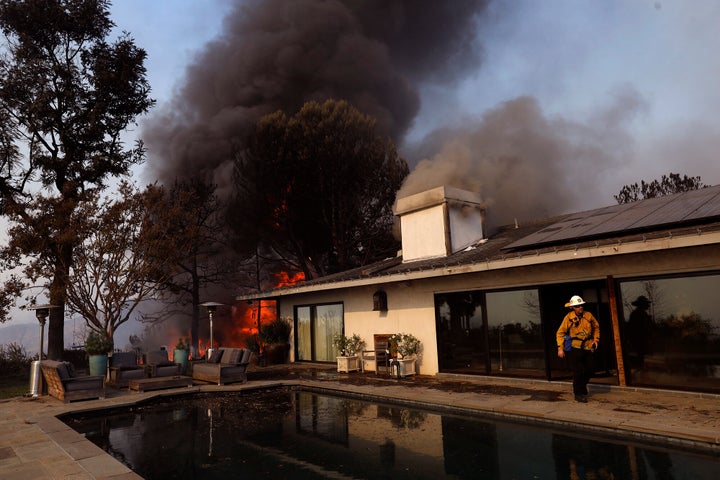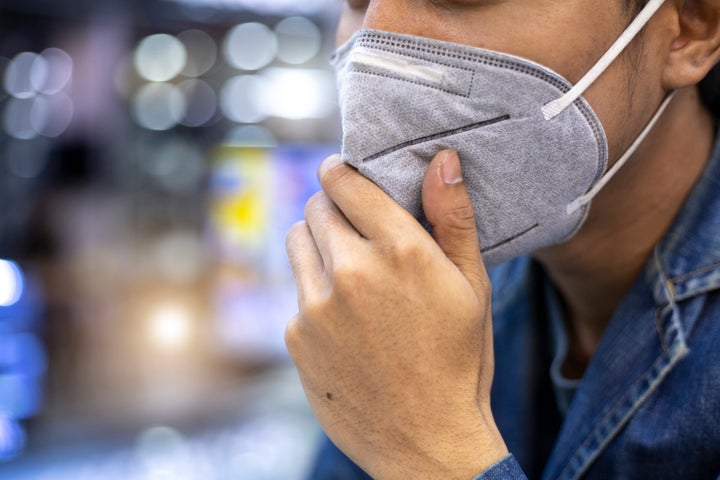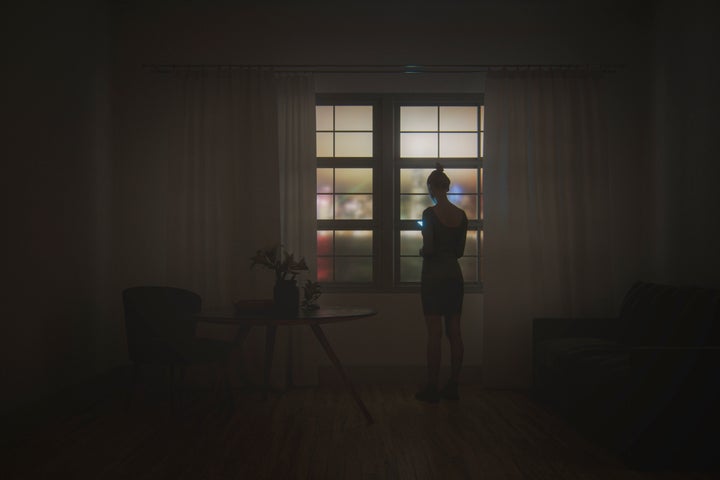For Californians, there’s a jarring familiarity and strangeness to seeing the wildfire smoke from Canada engulf the Northeast.
For Californians, seeing images of New York City and much of the Northeast covered in an eerie veil of smoke from wildfires in Canada is hitting close to home.
Smoke from wildfires hundreds of miles away has been lapping into the Midwest and East Coast since last month, but things took a turn for the worse on Wednesday because of a push from a storm system off the coast of Canada.
Photos and videos from Wednesday show Midtown Manhattan bathed in a deep hazy orange ― an unlikely sight in New York City but an all-too-common one throughout wildfire-plagued California.
“It’s jarring to see,” said Bryn Donovan, an author and editor who muddled through multiple Los Angeles wildfire seasons before relocating to Chicago in 2021, in part because of her husband’s respiratory issues.
The couple was most affected by the Skirball fire in 2017 and the Woolsey fire in 2018 (at the same time as the Camp fire, which killed 85 people in Northern California) and the Bobcat fire in 2020.

“The sun looks like a strange fluorescent red moon,” Donovan said. “We distracted ourselves with books, though we couldn’t read anything grim or dystopian ― it had to be lighter and more hopeful.”
On social media, some Californians have taken a certain blasé, “Now you know what it’s like” attitude toward New Yorkers blighted by wildfire smoke. The majority, though, seem saddened to see East Coasters suffer through the same anxiety and unhealthy breathing conditions that have become commonplace in California and the West.
#BREAKING: New footage from the George Washington Bridge (connecting New Jersey and New York City) of the toxic smoke now enveloping the northeast, as dozens of wildfires burn uncontrolled across Canada. #BreakingNews pic.twitter.com/7HjdJwMaEG
— Breaking 4 News (@Breaking_4_News) June 7, 2023
“As someone who lives in the Bay Area and has lived through decades of wildfires in California, there’s nothing good about seeing the same ecological disasters affect others, like it’s just genuinely upsetting!” journalist and podcast host Matthew Lawson tweeted Wednesday.
“Those months of fires in 2020 were fucking horrible ― wouldn’t wish that on anyone,” he added.
With air quality in New York City worsening across the five boroughs ― as of 4 p.m. EDT, the city’s Air Quality Index had reached 413, according to the AirNow Index (anything above 100 is categorized as “unhealthy” to breathe and anything above 300 is “hazardous”) ― we decided to ask Californians to share their advice for protecting yourself from wildfire smoke.
Don’t expose yourself more than you have to, even if you’re healthy.
Donovan urges East Coasters to take it seriously, even if they’re relatively healthy.
“We kept the windows closed, of course, and we stayed inside as much as we could,” she said. “On the worst days, if we stepped outside, it smelled like we were standing right by a campfire.” Donovan’s husband changed the HVAC air filters almost daily, and they would still get filthy.
“He also jerry-rigged additional air filters by attaching air filters to box fans,” she said. “He was using his inhaler, which he hadn’t used for about a decade before we moved to California. On bad days, my husband couldn’t take a full breath, and his doctor thought it was just as well if he didn’t try.”
Though it’s hard, try your darnedest to stay inside, Donovan said. During one particularly bad fire season, the author thought to herself, “I just need to get out of the house, I’ll be fine” and took a walk.
“My eyes burned and my lungs hurt for two days,” she said.
Put your old quarantine muscles to work, and limit your pet’s time outside.
Arik Warren of Los Angeles vividly recalls how frightening it was dealing with the still-new COVID-19 pandemic and about two dozen wildfires in Northern California in August 2020.
The smoke traveled down to San Francisco, where Warren was living in an old building downtown with no central air conditioning.
“There was this intense smoke in the city, and I had to keep the windows and doors shut at all times,” he said. “It was pretty terrifying. I do have a dog and had to go outside to walk him every day, so that was a challenge. Luckily I had my N95 masks, but I was definitely concerned about my dog.”
Pet experts told Britain’s The Independent that the biggest danger posed to dogs and cats ― and humans ― experiencing wildfire smoke comes from fine particles found in air pollutants, which can lodge in the lungs and cause a variety of health issues, including eye irritation and respiratory problems.
Warren said he tried to stay inside and limit his dog’s exposure as much as possible, which he was used to in the quarantine conditions.
“It’s fortunate we aren’t in lockdown, but I know it’s probably pretty scary for those in New York and Canada right now,” he said. “I would definitely advise everyone to stay inside if they can and wear an N95 mask when they have to go out. I would almost even treat it like a quarantine situation. Stay inside and stream those shows and movies!”
Mask up, and if you have an air purifier, use it.
For fire season around San Francisco, author May-lee Chai has saved N95 respirator masks she pulls out just for smoke days.
“I’ve found they’re better than KN95 for smoke,” she told HuffPost.
“I am the caregiver for my elderly, immunocompromised father, and smoke is especially dangerous for the elderly, so I have to be extra cautious.”
The author also has three air filtration machines: two small Levoit air purifiers she brings in for backup and a larger Blue Pure 211+ air purifier that she runs 24/7. If you have similar air filtration systems, use them now.
As for stress and anxiety, Chai recommends streaming as many comedies as possible.
“‘Schitt’s Creek’ got us through the hellscape of 2020 smoke-plus-pandemic,” she said.
Download an air quality app on your phone.
Cindy Grant of Fairfield, California, lives near where the LNU Lightning Complex fire occurred in 2020 and where the Atlas fire burned in 2017. She and her family were packed and ready to evacuate in 2017 as the fire approached their home. She remembers being virtually dependent on her air quality app through the ordeal.
“With an app, you can get an idea of how the air is in areas you frequent and if there is an area you should avoid due to the poor air quality,” Grant said.
“At home, keep your house or apartment windows closed,” she said. “Smoke seeps into everything you own.
If you’re driving, remember to keep your windows closed and hit your air circulation button to circulate on the inside, she added.

Look out for your neighbors and those in need.
Jamison Shea currently lives in Helsinki, Finland, but used to live in San Francisco, where they experienced the terrible air quality that spread through the city during the 2018 Camp fire.
“I’m originally from Buffalo, New York, and moved to San Francisco after college, so I didn’t know about wildfires or the smoke,” they said. “It’s definitely anxiety-inducing to look outside and see red, to not know when the sun and blue skies will come back.”
In moments of high stress, the most important thing is to take care of yourself and the people and creatures around you, Shea said.
“Do your neighbors have N95 masks? Does anyone need to be invited to gather around the air purifier?” they said. “Taping over any drafty windows or vents with plastic, like garbage bags, can help, too.”
Take care of your mental health.
The smoke can make your thoughts hazy, too, Shea said.
“You’re not at peak performance when you aren’t getting clean air, and that’s not your fault,” the author said.
“The air is full of ash and particles, and they’re collecting in your lungs ― it’s OK if you’re tired,” they said. “It’ll be a few days before the smoke clears and even longer for the smell to fade from your furniture and clothes, but wearing a mask, trying to stay at home and taking it easy on yourself is most of the battle.”
Mindy Marzec, a Disney and travel blogger who lives in Burbank, California, and deals with poor air quality due to frequent wildfires, also stressed the need to be easy with yourself.
“Seeing an orange, hazy sky can really mess with your mind,” she said. “It does feel like something out of a movie, like the world is ending. I have to lean on my meditation practices during those moments and remind myself that it’s temporary and the sky will return to its normal blue someday.”
Marzec also reminds herself that the majority of people surrounded by smoke and hazy skies can take relief in knowing that their lives and homes aren’t actually in any immediate danger from the fires themselves.
“It’s a temporary uncomfortable situation to tell yourself that, but someone out there has it worse than me,” she said.

If you really need to get outside, consult an app and seek fresh air elsewhere.
Tara Hayes lives in the San Joaquin Valley. Anytime there’s a fire in the mountains to the east or in the west, the air gets trapped in the valley. Even some of the smoke from the northern part of the state comes her way in Manteca, California, depending on how the wind blows.
Hayes tries to stay inside but fully understands how that can get to you mentally.
“You feel trapped. I would constantly look at an air quality app, and if the air quality was safe I would go outside as soon as possible,” she said. “Once I drove up to Fort Bragg, California, to get fresh air and took the kids with our bikes to be outside getting some exercise. It’s about five hours away but was worth the fresh air.”
Use the experience as a reason to get prepared for future emergencies.
Living in San Diego, pediatrician Jaime Friedman has experienced several wildfires that have led to closures, evacuations and poor air quality.
Dealing with wildfire smoke reminds you how important it is to be prepared for any natural disaster, the mom of two said.
“Keep a box ready to go with water, snacks and room to put important documents. Make a list of things you don’t want to forget, like medications, pet food, chargers and other valuables, and keep that list in the evacuation box as well,” she said. “You might even keep a file with photos of all items you would want your insurance company to be aware of in case they need replacing.”
If you have kids, help them understand what’s going on and remind them it won’t last forever.
During the Atlas fire in 2017, Grant remembers taking a ton of photos with her to document the crazy time they were going through together.
“My twins’ school was closed due to the heavy smoke and caused them to worry,” she said. “We talked through the stress we were under when we were packing up our belongings. It really makes you think about what is important (photos) and what isn’t (clothes, furniture). It also makes you remember life isn’t about the ‘stuff’ you own; it’s about the people you’re with and love.”
Credit: Source link